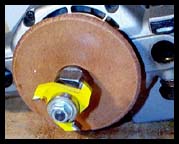

One of the concerns which woodworkers who operate routers mounted in router tables have is: just how much loose sawdust and chips will a table mounted router hold before it fills up and self-destructs? More years ago than I can remember for sure( probably close to eight or nine) I read about an easy to make accessory that all but does away with this concern. I wish I could remember what magazine or other publication I read the tip from, but I can't. So here is blind; but thankful attribution to the fellow who first suggested this method. . . wherever he may be.
 What you're going to end
up with is an accessory which will prevent stray items, chips
and sawdust from falling into the air ports of your router when
it is mounted upside down in your router table.
What you're going to end
up with is an accessory which will prevent stray items, chips
and sawdust from falling into the air ports of your router when
it is mounted upside down in your router table.
To begin, remove the base from the router so that you can get to the collet nut. Remove the collet nut and measure the diameter of the collet shaft and at the same time, determine what diameter disk would be free to rotate within the confines of the base housing once the router is reassembled. This is the diameter you will cut from a 1/8" or 1/4" piece of tempered hardboard scrap. Before you cut the large diameter for the disk, drill the hole for the router shaft. This sequence isn't critical and you may find it more expidient to cut the disk out first before drilling the shaft hole.
Using a an adjustable circle cutter (I use the General brand) cut the disk in the pre-determined diameter needed for any particular router. You'll notice that the edges of the disk are beveled. I believe this helps "streamline" the disk and allows it to spin more efficiently. If you do not like the beveled edges, just reverse the cutters and the edge will turn out squared. Keep in mind, that reversing the cutters throws the scale of the circle cutter's guage off, so you'll have to add about 1/4" to the guage's scale to end up with the diameter you need.
Once the disk is cut and the center shaft hole is drilled, just install the disk by turning it onto the router's shaft. The fit needs to be such that the disk will not "free-wheel" on the shaft. Position the disk just at the point where the collet will not be interfered with when it is completely tightened. (See photo)
Reassemble the router, install whatever bit you wish, place the router in the table and sling that sawdust away!
C.E. "Chuck" Ring